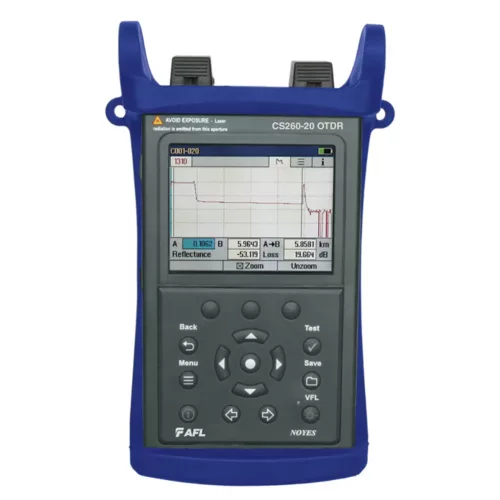Description
SmartAuto Provides Network-optimized Test Settings
In SmartAuto mode, a FlexScan OTDR automatically determines the characteristics of the network under test and rapidly completes multiple scans using a variety of network-optimized acquisition settings. It precisely locates and identifies network events, as well as measures loss and reflectance for each detected event. For even greater ease-of-use, FlexScan checks for live fiber and verifies the OTDR launch connection before initiating a test. Dual and triple-wavelength FlexScan OTDRs also provide automatic macro-bend detection.
LinkMap Simplifies Network Troubleshooting
LinkMap with Pass/Fail enables even novice users to easily and accurately troubleshoot optical networks. LinkMap presents an icon-based view of the tested network clearly identifying fiber start, end, connectors, splices, PON splitters, and macro-bends.
A LinkMap Summary provides end-to-end link length, loss, loss per distance and ORL. Loss and reflectance of detected events is compared to industry-standard or user-settable pass/fail thresholds and displayed with clear pass/fail indications. Users can instantly toggle between LinkMap and Trace views.
Bluetooth and WiFi for Faster Connectivity
Pair FlexScan with AFL’s FOCIS Flex connector inspection probe for fast, easy connector end-face inspection. FOCIS Flex provides auto-focus, auto-centering, integrated IEC pass/fail analysis,
and automatic Bluetooth transfer of images and pass/fail results to FlexScan for display and archiving.
Complete Testing with a Single Tool
FlexScan integrates a Visual Fault Locator (VFL) plus an optional optical laser source (OLS) and optical power meter (OPM) supporting AFL’s unique Wave ID capability. With Wave ID, the power meter automatically synchronizes to a single or multiwavelength Wave ID optical signal sent by an AFL light source. The power meter automatically identifies received wavelengths and measures power and loss at each wavelength, saving significant test time and eliminating setup errors. The VFL’s eye-safe red laser enables users to visually pinpoint the location of macrobends and fiber breaks often found in splice closures and fiber cabinets.














 Request Call Back
Request Call Back WhatsApp us
WhatsApp us